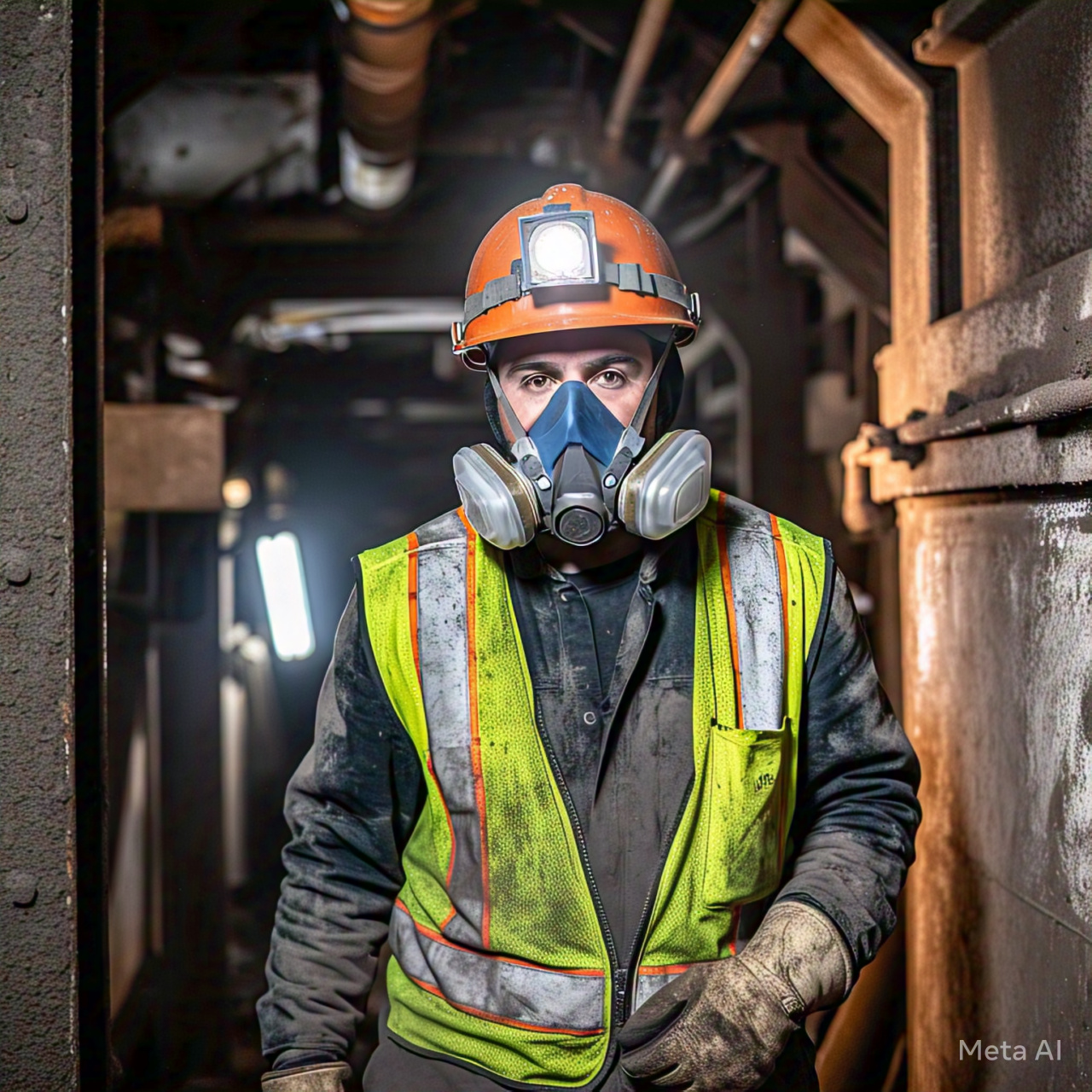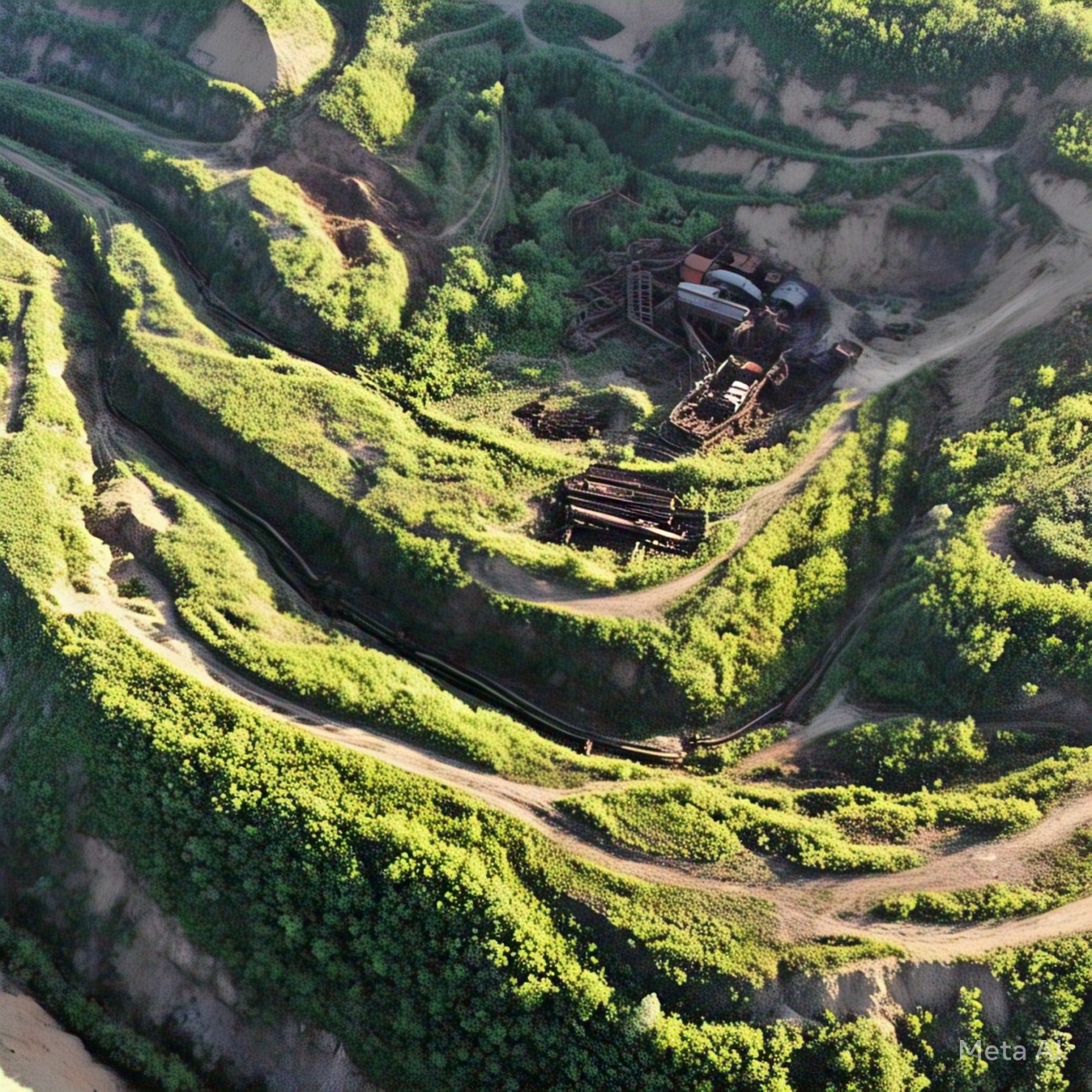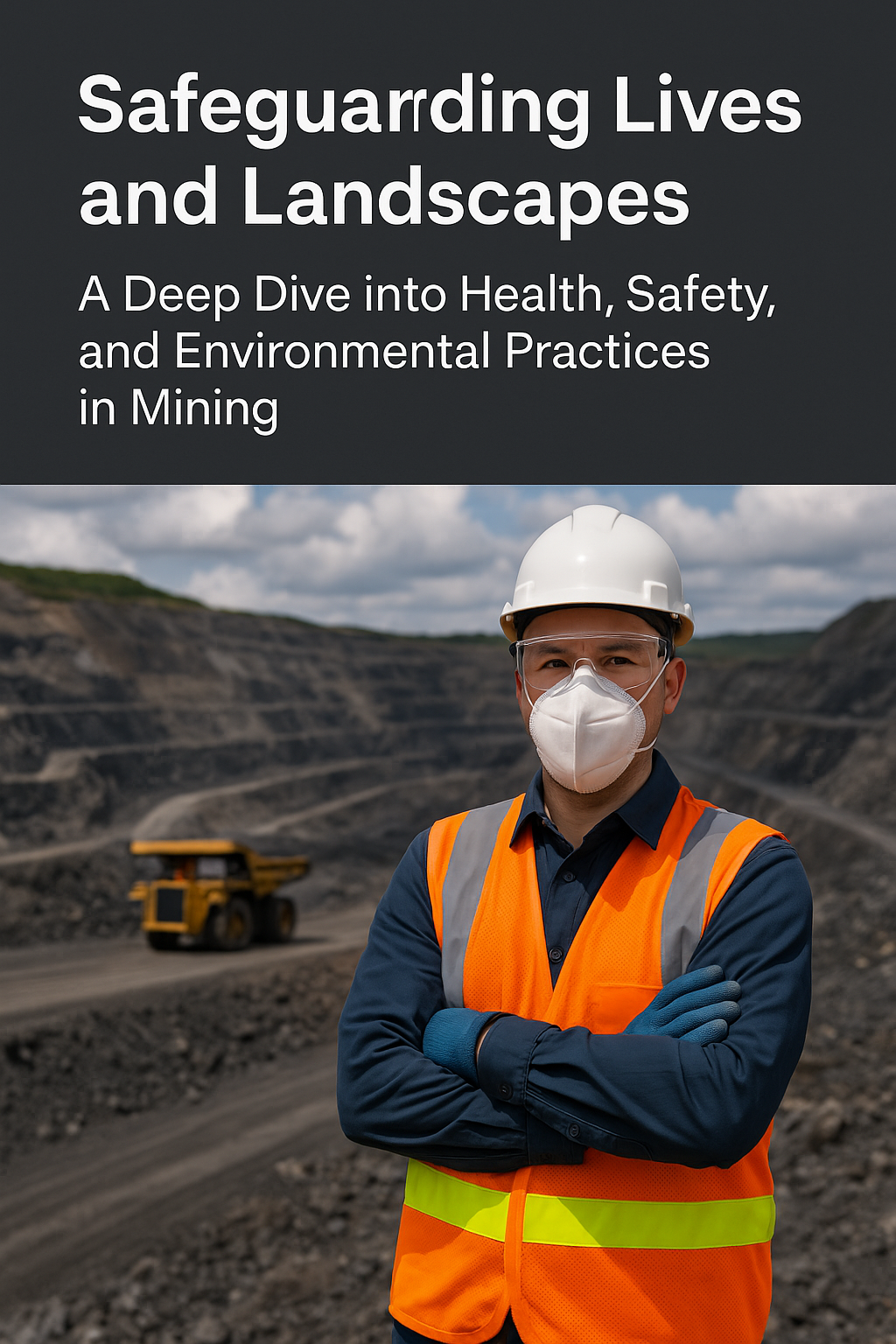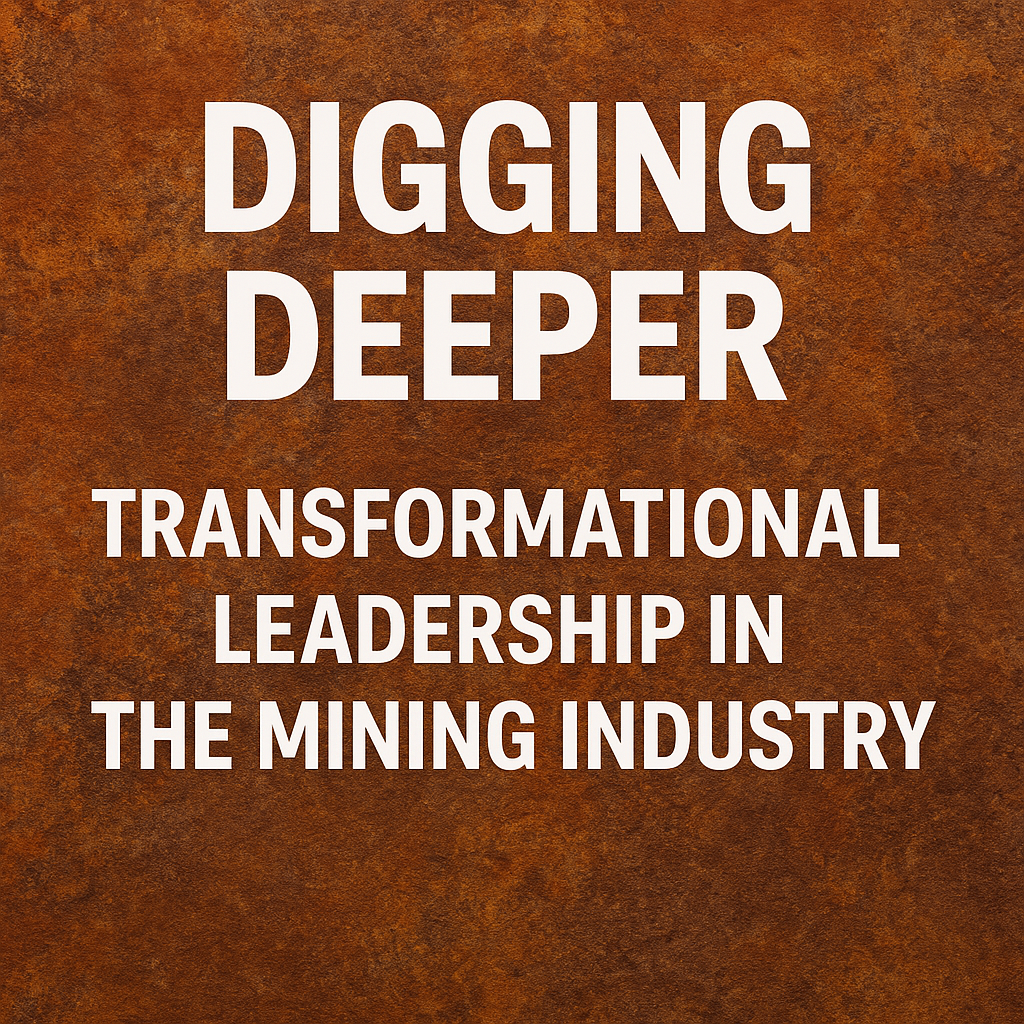SAFEGUARDING LIVES AND LANDSCAPES: A DEEP DIVE INTO HEALTH, SAFETY, AND ENVIRONMENTAL PRACTICES IN MINING
Mining has been a cornerstone of human progress for centuries—fueling innovation, infrastructure, and industry. From the iron and copper used in our buildings and electronics to the gold and lithium powering our economies and green technologies, mining remains indispensable. However, the extraction of these vital resources comes with serious responsibilities, particularly when it comes to protecting human lives and the natural world.
The mining environment is inherently hazardous. Workers often operate in extreme conditions—deep underground, surrounded by heavy machinery, exposed to hazardous gases, and vulnerable to rockfalls or equipment failure. Beyond the mine site, mining activities can have far-reaching impacts on the environment, including deforestation, water pollution, biodiversity loss, and air contamination.
As global attention turns toward sustainable development and corporate responsibility, the mining industry is under increasing pressure to not only boost production but also prioritize Health, Safety, and Environmental (HSE) standards. These pillars are no longer optional—they are essential for ethical operations, legal compliance, and social license to operate.
This blog dives into how the mining industry is responding to these challenges by implementing comprehensive HSE frameworks. We’ll explore real-world strategies, cutting-edge technologies, and examples of how mining operations are evolving to become safer for workers and cleaner for the planet.
HEALTH IN MINING
The health of workers in the mining industry is a top priority—but it’s also one of the most complex challenges. Mining sites, particularly in remote areas, often expose employees to a unique combination of physical, chemical, and psychosocial hazards. The nature of the work—long hours, confined spaces, repetitive tasks, and exposure to potentially harmful substances—can lead to serious short- and long-term health issues if not properly addressed.
Occupational Health Risks
Miners are at risk of several occupational diseases, such as:
a. Pneumoconiosis (Black Lung Disease): Caused by prolonged inhalation of coal dust.
b. Silicosis: A lung disease linked to inhaling crystalline silica from stone, sand, or ore.
c. Noise-Induced Hearing Loss (NIHL): From continuous exposure to loud drilling and blasting operations.
d. Musculoskeletal Disorders (MSDs): Due to repetitive lifting, vibration from heavy machinery, and awkward postures.
These are not just statistics—they’re lived experiences that can impact a worker’s ability to earn a living and live a healthy life. That’s why proactive health measures are so vital.
Health Surveillance & Monitoring
Many mining companies now run routine health surveillance programs, which involve:
a. Baseline health assessments before employment.
b. Periodic medical screenings to detect early signs of disease.
c. Exposure monitoring using personal and environmental sensors to track air quality, gas levels, and noise.
d. Health data analysis using digital platforms to spot trends and risk clusters early.
Early detection is crucial. It allows employers to intervene before symptoms progress, often saving lives and livelihoods.
Mental Health: The Silent Risk
While physical health is closely monitored, mental well-being is an emerging focus area. Mining work can be isolating and stressful—especially in fly-in/fly-out (FIFO) roles that separate workers from their families for weeks.
To address this, companies are introducing:
a. On-site counselling and wellness programs.
b. Peer support networks and mental health hotlines.
c. Stress management workshops and resilience training.
The goal is to create a culture where workers feel safe not just physically, but emotionally—where asking for help is seen as strength, not weakness.
Preventive Measures & Education
Education is a key tool in promoting health in mining. Regular toolbox talks, safety briefings, and interactive health campaigns equip workers with the knowledge to protect themselves and their peers.
Topics often include:
a. Proper PPE usage and maintenance.
b. Ergonomics and injury prevention.
c. Hydration, nutrition, and fatigue management.
d. Early signs of illness and when to report symptoms.
Some mines even have on-site clinics or mobile medical units, offering basic healthcare services, vaccinations, and first-aid treatment to ensure immediate care when needed.
Health in mining isn’t just about compliance—it’s about compassion. A healthy workforce is a productive workforce, and companies that invest in employee well-being often see improvements in morale, retention, and operational efficiency. When health is valued as highly as production, everyone wins—from the mine site to the communities beyond.

A miner wearing full PPE gear underground or on-site
SAFETY ON THE GROUND
Mining is one of the most physically demanding and high-risk industries in the world. From deep underground tunnels to open-pit operations, the risk of accidents—ranging from minor injuries to catastrophic incidents—is ever-present. That’s why safety on the ground is not just a regulation—it’s a philosophy that every responsible mining company must embrace.
Understanding the Risks
Every stage of the mining cycle introduces safety hazards:
a. Drilling and blasting can cause fly rock, ground instability, and seismic tremors.
b. Haul trucks and loaders pose collision and roll-over risks.
c. Working at heights or in confined spaces increases the likelihood of falls and entrapment.
d. Heavy machinery and conveyor belts can cause crush injuries if not properly guarded.
e. Fires and explosions from flammable gases or equipment malfunction are always a potential threat, especially in underground settings.
These are not just hypothetical dangers—they’ve cost lives in past incidents, highlighting the urgent need for robust safety frameworks.
Proactive Safety Systems and Technology
Modern mining companies are turning to advanced systems and technologies to make their operations safer and more predictable:
a. Real-Time Monitoring Systems: Sensors and IoT devices are embedded throughout the mine to monitor gas levels, vibration, temperature, and structural stability. These systems can trigger alarms and automatic shutdowns to prevent accidents.
b. Wearable Tech: Miners can wear smart helmets and GPS trackers that monitor fatigue, exposure to hazards, and even vital signs. This data helps supervisors make timely interventions.
c. Drones and Robotics: Remote-controlled drones are used to inspect unstable areas and machinery, reducing the need for human entry into dangerous zones.
d. Collision Avoidance Systems (CAS): On-site vehicles are now fitted with AI-powered CAS that prevent accidents by warning drivers of potential collisions with people, equipment, or terrain.
Emergency Preparedness
When accidents do occur, preparedness can be the difference between a close call and a tragedy.
a. Emergency Response Teams (ERTs) are trained in rescue, firefighting, and first aid. They perform mock drills and simulations regularly to stay sharp.
b. Clear Signage and Escape Routes are marked across mine sites, with designated assembly points for swift evacuation.
c. Communication Systems—such as underground radios, digital noticeboards, and PA systems—ensure that emergency alerts are rapidly broadcasted to all personnel.
Some operations even use refuge chambers underground—sealed rooms stocked with oxygen, water, and communication tools, providing safe space for workers until help arrives.
Training and Safety Culture
A strong safety culture is built on training, accountability, and communication.
a. Induction programs for new employees cover site-specific hazards, rules, and emergency protocols.
b. Daily toolbox talks keep safety top of mind, focusing on real incidents, near misses, and lessons learned.
c. Behavior-Based Safety (BBS) initiatives encourage workers to speak up about unsafe practices and take personal responsibility for their environment.
d. Incentive Programs reward teams and individuals who consistently follow safety protocols and report hazards.
More importantly, leadership sets the tone. Supervisors and managers who model safe behavior and encourage open dialogue foster a culture where safety is everyone’s job—not just the safety officer’s.
Aiming for Zero Harm
Many mining companies today adopt a "Zero Harm" policy—a commitment to achieving zero fatalities and minimizing all forms of harm on-site. While ambitious, this goal has driven innovation and improved accountability across the industry.
It reflects a broader truth: Safety isn’t a checklist—it’s a mindset. When miners feel safe, respected, and equipped to do their jobs without fear, the entire operation becomes more efficient, ethical, and resilient.

Emergency evacuation drill with safety officers guiding workers
ENVIRONMENTAL RESPONSIBILITY
Mining has historically had a significant impact on the environment—often leaving behind scars that outlive the lifespan of the operation. From deforestation and water contamination to air pollution and biodiversity loss, the environmental footprint of mining can be immense if not managed responsibly. However, in recent years, a growing global emphasis on sustainability and corporate accountability has reshaped how mining companies approach environmental stewardship.
Today, environmental responsibility is no longer an afterthought—it’s a strategic priority. Governments, communities, investors, and international regulatory bodies are all demanding cleaner, greener mining practices that protect both ecosystems and human health.
Land Reclamation and Site Rehabilitation
One of the most visible and impactful environmental concerns in mining is land degradation. Open-pit mining, in particular, can drastically alter landscapes. To mitigate this:
a. Progressive Rehabilitation is carried out during the life of the mine, not just after closure. This involves reshaping landforms, replacing topsoil, and planting native vegetation in already-mined areas.
b. Post-closure Land Use Planning transforms exhausted mines into parks, farms, lakes, or renewable energy sites—contributing positively to local development.
c. Biodiversity Conservation Programs aim to protect endangered species and restore ecological balance, often in collaboration with local wildlife organizations.
A great example is how some former mining areas in South Africa have been converted into thriving game reserves, attracting tourism and boosting the local economy.
Water Management and Pollution Control
Mining operations require substantial amounts of water, often in water-scarce regions. Poor water management can result in the contamination of rivers, lakes, and groundwater—endangering local communities and ecosystems. To combat this:
a. Water Recycling Systems are installed on-site to minimize freshwater use and reduce waste.
b. Tailings Dams are being redesigned with enhanced safety features, including real-time monitoring of structural integrity and water levels.
c. Effluent Treatment Plants purify contaminated water before it is discharged, ensuring it meets environmental standards.
d. Dry Tailings Technology, where feasible, reduces the risk of dam failure and groundwater pollution by eliminating liquid tailings storage altogether.
Air Quality and Dust Control
Mining activities such as blasting, crushing, and transportation generate large amounts of dust and airborne pollutants. This affects not only miners but nearby communities and agricultural land.
To manage air quality, companies implement:
a. Dust Suppression Systems, such as water sprays and fog cannons on haul roads and crushing plants.
b. Air Quality Monitoring Stations that continuously track particulate matter and alert management to rising pollution levels.
c. Vegetative Buffer Zones or green belts around mine sites, which help absorb dust and improve air quality.
d. Emissions Control on Equipment—including filters and cleaner fuels—reduces the carbon footprint of mining vehicles and machinery.
Waste Management and Circular Economy
Mining generates vast amounts of waste rock, tailings, and overburden. Improper disposal can lead to soil contamination and long-term environmental degradation.
Sustainable mining companies are:
a. Segregating and Recycling Waste wherever possible—including used oil, plastics, and metal scraps.
b. Exploring ways to reuse tailings in construction materials or backfilling operations.
c. Investing in circular economy models where waste from one process becomes input for another—minimizing overall waste generation.
Energy Use and Climate Action
Mining is energy-intensive, and traditionally, much of that energy has come from fossil fuels. As part of global climate action, the industry is making major strides toward decarbonization.
a. Solar, wind, and hybrid energy systems are being deployed at remote mining sites to reduce reliance on diesel.
b. Energy-efficient equipment and automated machinery are replacing older, fuel-hungry machines.
Some companies are adopting carbon offsetting programs and publishing their emissions in line with frameworks like the Task Force on Climate-Related Financial Disclosures (TCFD).
Community Engagement and Environmental Transparency
Transparency is a key component of environmental responsibility. Mining companies are increasingly involving local communities in environmental monitoring efforts, sharing environmental impact assessments (EIAs), and responding to concerns in a timely and open manner.
a. Environmental grievance mechanisms allow community members to raise issues and seek redress.
b. Public environmental reports provide data on water use, emissions, biodiversity, and reclamation progress.
c. Community-based environmental monitoring programs empower local residents to participate in oversight and protection of their natural surroundings.
Mining with a Conscience
Environmental responsibility in mining is not just about compliance—it’s about mining with a conscience. The industry is at a turning point where sustainable practices are not only possible but necessary for long-term viability. When companies prioritize the planet alongside profit, they earn trust, create lasting value, and protect the very ecosystems that support human life.

Drone view of land reclamation efforts, showing greenery replacing an old mine
Mining doesn’t have to come at the cost of lives or nature. With robust HSE practices, mining companies can protect their workforce, minimize environmental damage, and operate more ethically and sustainably. The industry still has a long way to go—but every step counts toward a safer, greener future.



 Emmanuel Essel Afful
Emmanuel Essel Afful

